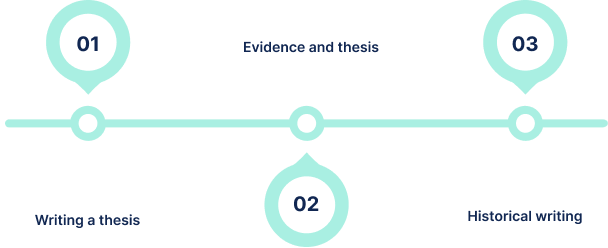- Writing philosophy papers professionally
- How to write English essays professionally and what our writing service can offer
- Writing nursing assignments, papers, nursing reports and nursing case studies writing service
- What makes a good historical work great and interesting and how academic paper can help
- How to write a scientific paper. Research development writing services
- Writing services by subject types
- Modern writing of an economic paper. What to take into consideration while selecting a writing service
What makes a good historical work great and interesting and how academic paper can help

There are two basic elements of writing an academic history essay: writing a thesis and providing evidence. These are divided into three sections namely the introduction, the development of an argument or counterargument, and a conclusion. These guidelines are important for writing any academic history essay. Probably, you an idea of what you want write about but you are finding it difficult to write it because you are limited by the skill. Our experience writers will write for your A+ history paper. We shall only require you to identify your professor’s question and the goal of your assignment and we write for you a history essay that meets your professor’s requirements.
Requisites of Writing A History Essay

Writing a Thesis
A thesis is the statement and argument you present when writing a history paper. It is your interpretation, position and approach to the research question. It requires more than restating the instructor’s question. You must demonstrate critical thinking and originality by showing the issue being addressed in the research question and why it is worth addressing. What matters is your own perspective. Indeed a thesis is a “perspective” or “point of view” based on your belief, systematic and logical argument backed by evidence. A good critical history acknowledges that a research question has multiple perspectives. It must demonstrate the correctness and validity of the author’s own view.
Evidence and Thesis
The argument you present must have two things: plausible evidence and a strong central thesis. The two supports each other but they are interdependent. For a strong central thesis to convince your professor, it must have evidence. Equally, list of details, dates and quotes have no meaning if no evidence is provided to support them. Your task in a history paper is to ensure your important facts are presented in a reasonable, systematic and persuasive manner. To defend your position and argument, you should use footnotes and create bibliography for your essay. The footnote is your way of demonstrating your thesis against the evidence. Your instructor will rate the validity and originality of your argument basing on the original source. Ensure your notes are accurate and the argument is strongly rooted in concrete evidence.
Historical Writing
You should note that “historical” writing slightly differs from other forms of writing in natural science, literature or other social sciences. Though they all tend to follow the evidence model and general thesis, historical writing largely depends on situating evidence and argument correctly in space and time. You should be sensitive to anachronism errors. Ensure you put events in a correct order. You should also make historical characters think, act and speak in ways that are appropriate for the time the characters lived. Avoid reading the past in terms of present and existing experiences. You should avoid making grand statements about people or humanity. Be carefully when using theories that fit all cases. You should make a point using evidence while paying attention to specific places, time and context.
Steps in Writing a History Paper
- Understanding the question
You should pay particular attention to the way the question is presented and worded. For example, be aware that “describe”, “evaluate”, “analyze”, or “compare/contrast” do not mean the same thing. Note the key words and define them properly. Consider the evidence you require to respond effectively to the essay. Stick to the paper topic and only include important issues.
- Prepare the Material
Start by reading and re-reading your documents or texts. To be guaranteed of good writing, avoid rushing through your assignment. Read with the aim of identifying critical arguments in the document or text. Read to understand the text but also critically examine and re-examine the materials and sources. Note the main argument presented by the author. Look at what the author’s stated and unstated assumptions. What evidence does the author provide to support the argument? What do particular texts or documents tell you about when (time) the text was written?
- First Draft
All serious writing should be done in drafts. Ensure you dedicate enough time for reviewing and revising your writing. Do not turn in a paper that you have never read yourself. Think of the “preliminary” or first draft as your detailed outline. First come up with the thesis and assess it to ensure it is not too specific or general. Does it effectively address your instructor’s question? Refine your thesis as many times as possible as you continue writing and reading.
While writing your draft, be attentive to the following issues:
Organize your ideas by ordering your arguments and connecting them to supporting evidence. Order and construct your paragraph and make them logical. Your paragraph should be several sentences long and have strong topic sentences Be attentive to transitions. When switching to a new argument, provide a topic sentence to let the reader know. Take time with the conclusion. Ensure your conclusion summarizes and closes your arguments. Be aware that a conclusion impacts on your reader. Your work will be evaluated by the reader. As such, you should present the best presentation possible.
- Drafts and Final Draft
After completing your draft, go back to the introduction of your paper. Check whether your thesis is clearly stated. Also check to see whether your argument is clear and has been supported by evidence. If necessary, rephrase your thesis. Add examples, delete non-relevant materials and ensure your paragraphs are well connected with topic sentences and transitions. Proofread your work by reading it aloud. Ask someone else or a friend to read your work. Finally, check for spelling, sense, grammar, typographical and mechanical errors.